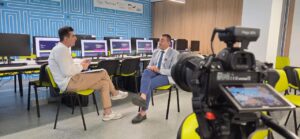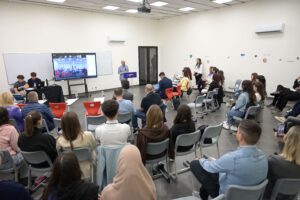PhD proposal
PhD director and co-director(s)- Albania: Prof. Dr. Nikolla Civici (ncivici@umt.edu.al)
PhD academic supervisor – USA: Erion Plaku (plaku@gmu.edu)
Context and general objectives
Research areas:
-
- Artificial Intelligence to intelligently decompose the terrain to create a map that facilitates in-depth search used to perform autonomous navigation of a mobile robot.
-
- Machine Learning to enable a mobile robot to learn through experience how to effectively interact with surrounding environment.
-
- Robotics: motion planning to generate a path of collisions-free dynamic trajectories that obey differential constraints from a start position to a goal destination.
Objectives of the project
The main goal of this research project is to develop a framework that enables mobile robots to be more autonomous, independent and efficient, in order to facilitate their successful deployment in the real world.
Scientific research will focus on the integration of Artificial Intelligence and Machine Learning techniques with Motion Planning for robotic systems with one or multiple agents, processing the terrain through its geometric characteristics.
The main goal of artificial intelligence and machine learning is to develop algorithms that handle complex problems that require intelligence and that can improve their performance through experience. As such, machine learning is a very effective methodology to apply in those areas in which there are many observations, but where no qualitative models exist to explain these observations. Machine learning provides a sound mathematical framework to handle the lack of complete information and unpredictability in receiving information (sensing) or performing actions (acting) through an effective and scientific model.
Motion Planning will empower a mobile robot to move from an initial position to a goal destination, obeying the laws of dynamics and physics in its movements, and in any case and avoiding collision with obstacles.
The integration of these methodologies and the development of sound frameworks will aim to increase the ability of robots to plan and act independently and autonomously. The long-term goal is to increase the productivity and capabilities of robots to effectively perform tasks, or work assigned by humans, in assistance, or instead of them.
Scientific program / Methodology / Expected results
Autonomous navigation in unstructured, complex and unpredictable environments is an essential skill for intelligent robots. Autonomous robots must continuously plan which parts of the terrain are traversable and which should be avoided while reaching the final destination.
The research work of this project will focus on the development of algorithms that enable equipping a robot with the ability to move independently, efficiently, and safely in complex and previously unknown terrains.
To achieve this goal, we will leverage machine learning with robotic motion planning.
Machine learning algorithms can be used effectively to allow a robot to learn through experience, without providing the motion planner with a cost or reward function to guide the motion. The main goal is to interpret the raw data collected by the various sensors, and extract from them information that can be used to navigate effectively and safely.
Terrain decomposition provides an abstraction layer to be used to guide motion planning to build a tree of motions toward the destination that avoids obstacles at all times. The main aim is to divide the terrain into a map which can be more easily navigated. To achieve this objective, the idea of superfaces will be explored, which allow the drastic reduction of the number of regions/areas, from millions of such to only a few hundred.
Terrain decomposition provides an abstraction layer that allows the selection-based motion planner to expand a tree of motions toward the destination that in any case avoid obstacles and are dynamically feasible motions
While considering motion dynamics, sampling-based motion planning algorithms search for solutions by expanding and exploring a motion tree that has as its branches motion trajectories that do not encounter obstacles and that are dynamically possible.
In this context, the results that this research project aims to achieve can be summarized as follows:
-
- The development of methodologies that ensure the increase in the degree of autonomy and efficiency of action in robots
-
- Creating a framework for integrating artificial intelligence and machine learning algorithms and geometric processing with motion planning for a robotic system
-
- Developing algorithms that allow a robot to learn to navigate autonomously through experience
-
- The development of efficient methods and algorithms for planning the movements of a robot based on the concept of expanding a tree of movements towards areas of higher interest, according to the specific definitions of these areas.
-
- The development of a wide range of terrains or type of environments, which can be widely used by other researchers, to test the effectiveness of autonomous navigation, or other problems.
-
- The publication of methodologies and algorithms developed in national and international journals, through which the sharing of innovations with the scientific community is aimed, and therefore the further development and advancement of this research field.
-
- Creation and development of an interaction environment for the robot, created virtually (through the Robotic Operating System (ROS)) in which the interaction algorithms of the robot can be studied through its behaviors with the surrounding environment
-
- Encouraging and developing a community of scientific researchers, researchers, students or professionals passionate about Artificial Intelligence and Robotics who can contribute to the further development of this field
-
- Encouraging, strengthening and developing cooperation with the software development industry in Albania, with which it is intended to find effective ways of cooperation with the aim of applying the developed techniques in practical applications that serve the community
Selected references
A. Khan, C. Z. (2018). Memory augmented control networks. International Conference on Learning Representations .
Atanasov, T. W. (2020). Learning Navigation Costs from Demonstration in Partially Observable Environments.
Kamel, C. X. (2016). Neural inverse reinforcement learning in autonomous navigation. Robotics and Autonomous Systems
Kavraki, I. A. (2012). A sampling-based tree planner for systems ëith complex dynamics. IEEE Transactions on Robotics .
P. Karkus, X. M. (2019). Differentiable algorithm networks for composable robot learning. Proceedings of Robotics: Science and Systems .
Plaku, E. (2015). Region-guided and sampling-based tree search for motion planing with dynamics. IEEE Transactions on Robotics .




